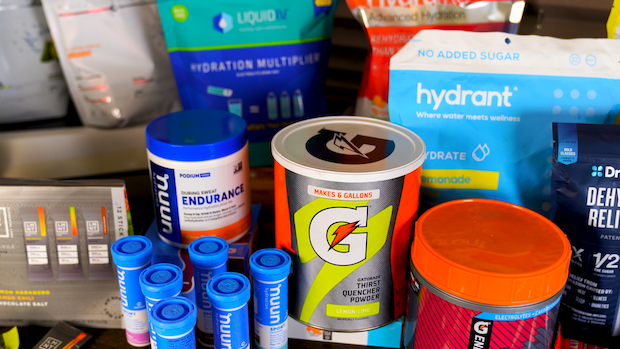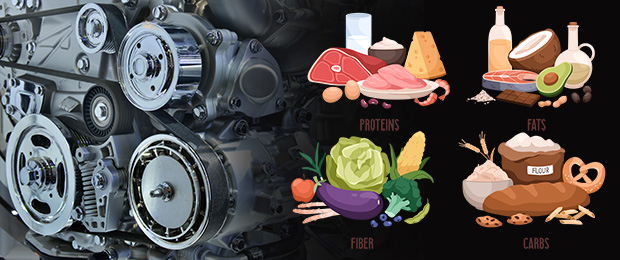Sports Nutrition Series: Factions in the Fueling Camps

There are usually “camps” of thinking in the nutrition space. They usually take on a name, and sometimes even a persona. This has never been more true than in the workout fueling debate scene. The age-old question of what to consume during training and racing has been a plague for many athletes’ entire careers.
Unfortunately, for most folks' clarity on what they should be doing nutritionally during training and racing lately, the “camps” have splintered more than ever, as I see it, and I hope to clarify those camps, and what it might mean for you personally.
Years ago it was the low-carb vs. high carb camp, and not much else. The no-carb (aka keto, high-fat, fat adapted, LCHF, etc) camp still exists, but the “pro-carb” camp has grown some branches as it’s begun to win the long-standing debate. Understanding each of these thought lines and what they promote has been informative for me. I think it may be for you as well.
So what are the camps that currently occupy the intra-workout and intra-race fueling space?

Fat adaptation via carb restriction.
The premise is: burn more fat, spare your carbs, avoid the gut issues that high intra-workout carb fueling strategies are replete with.
I promise I know the arguments for fat adaptation like the back of my hand. I wanted to believe. I’ll spare you the full physiological underpinnings because there have been books written on this. I don’t recommend reading them because they virtually all fall into the “mechanism therefore application” fallacy so common to exercise scientists who want to believe they’ve discovered the next performance hack.
Suffice it to say, I wanted to believe camp 1 was a cool camp. I then moved into the “maybe there’s something to carb periodization” camp, for the same effect. Burn fat, spare carbs, enhance performance on race day, less gut issues, etc.
It just doesn’t pan out and comes fraught with tradeoffs. But, fat adaptation also isn’t as bad, in some cases, as the high-carb zealots might make it out to be. Keto can work for some folks. For others, it’s a disaster, and for lots of folks, it’s just not quite up to snuff.
I generally don’t advise it because the hormonal complications, when they happen, are nothing short of alarming, and sometimes hair raising… or hair growing, if you know what I mean. Fair warning, there are more hucksters in this camp than others so keep your “don’t get sold” radar turned on high alert if you decide to dabble here.
High Carb Zealots
High carbs all the time. Little regard for personalization. Little to no regard for anything other than performance.
First, what do I mean by high-carb? I mean hourly rates of carb intake during training that exceed 60 grams per hour, and these days, there’s a group promoting 80-100 grams per hour for the vast majority of training sessions, with many going even higher than that.
Reminder here: “intake” means what you put in your body, while uptake refers to what your gut actually transfers to your bloodstream, where it’s needed
High carbs all the time might truly enhance your performance. And there appears to be pretty sound evidence that exceeding 100 grams per hour, sometimes by a lot, is useful in some cases.
But, using this extreme approach, all the time, is more likely to work great if you’re 18 and raging full of testosterone. For those of us in our later 20’s, 30’s and beyond, at best, it’ll work fine. At worst, you’ll be hungry outside of training, gain weight, cause blood sugar dysregulation, and eventually hurt your performance too, roughly in that order. You don’t need to intake 100 grams per hour on a 90 minute recovery ride. You’ll be healthier and have better performance long-term in 99% of cases, if you modulate your carb intake with the intensity and duration of your training sessions.

Food First
It’s a newer one. It’s making headway in the research. And the researchers here appear more adept at turning a blind eye to glaring holes in their position than researchers in most other areas in nutrition, and that’s saying something. I think I understand though. They’re quite reasonably fearful and even angry at the potential side-effects of the high-carbs, and especially the “high sugar all the time,” folks in camp 2.
Food-first fueling appeals to health-focused hearts and minds, and those who are concerned about the long-term effects of sucking down sugar like it’s going out of style.
This camp likes to think that it’s possible for all people to get all their carbs from solid “whole food” sources, while fueling performance optimally. It’s an overly holistic health-focused backlash to the use of sugar during exercise. I understand where this camp is coming from though, because there have been and will continue to be very negative effects of sugar overconsumption.
The problem is that sucking down sugar during exercise is dramatically different from any other time in the human experience. The harm of high blood sugar on the all-important pancreas is non-existent while exercising because insulin production is minimal. The hormonal environment and cellular signaling in many tissues is simply wildly different during exercise than at rest. It’s the high rates of insulin production that tend to be harmful. That just doesn’t happen during exercise. There’s no need. Why? Muscles are 50x more sensitive to insulin during exercise. That is, they take in 50x more glucose for the same circulating insulin levels, largely because of increased GLUT4 activity.
If you don’t remember your GLUT molecules and what they do, they’re glucose transporter molecules that exist on cell membranes. GLUT4 is mostly on muscles. And it’s most happy to act as a vacuum for glucose, from the bloodstream, into muscles, during exercise. It’s a highly effective blood glucose vacuum while you’re training and racing.
The food first approach during training and racing tends to ignore that very high rates of carb fueling are appropriate, healthy, and performance- & fitness-enhancing for most folks, when training & racing goes very long. It also ignores that these high rates of fueling tend not to be possible without using simpler forms of carbohydrate. There simply will be more gut distress (read: bathroom trips and pain) when you try to consume>80 grams per hour with whole food sources of carbs. There’s too much fiber, fat, and protein, and each of these acts to slow down absorption of whatever it’s consumed with.
Not a good thing when your gut has limited resources and capabilities already, during exercise.

Periodized Carb Intake
This is the approach I wanted to love.
Periodized carb intake initially was coined to mean: a method of periodically training with low carbs, before, during, or after training, or limiting consumption periodically before or after a night of sleep, in an attempt to increase fitness gains or fat oxidation capability during exercise. In short, play with when carbs are consumed to cause a cellular performance advantage.
It certainly sounds like a promising antidote to Camp 1’s zealotry. There are a few optimization protocols floating around the internet, and there are submethods within this camp. At the core, each method here targets metabolic flexibility, ie. be able to burn fat at a high rate but also be able to burn carbs at a high rate.
It turns out, what really ends up happening is you end up under-fueled for some sessions, sometimes don’t sleep as well, do indeed get better at burning fat, but no more improvement at that, than you lose at being able to burn exogenous carbs.
The result: no performance enhancement, and sometimes more fatigue, worse recovery and training adaptation, and worsened performance, especially when compared to…

Individualized
I think this is where many old-school athletes who have sort of “figured it out” naturally end up falling, with one caveat: they probably don’t take the carbs quite high enough to optimize performance when performance is all they care about at something like an “A” race.
Okay, so you’re not a high-carb zealot, you’re kind of into the sound of periodized carb intake and like the idea of being able to eat more real food but don’t want to be leaving performance on the table. Me too. I like eating tasty foods. I like having something solid when I train, sometimes. But sometimes I like to keep it simple especially when my gut comfort is a deciding factor in my training or racing. I like to enjoy my life and have balance.
I don’t love the idea of choking down sugar and salt all the time, but I’ll do it sometimes if it means faster times with less risk of GI issues. I’m not a hummingbird after all but I can behave like one if I need to.
Oh, and fat adaptation, can we just not and say we did? Cool.
An individualized approach targets high carbs when it matters, less when it doesn’t, for you, personally. Individualized intuitively, all the time. Holistic and health-considering, and performance-focused when it counts. The goal is to consider the factors in real life that matter, while fueling for performance. Sometimes that means lower carbs during training. Maybe it’s 20 grams per hour, or maybe it’s 50 grams per hour. Just lower than whatever “usual” is for your more quality or longer sessions. The point is, do so intuitively, comfortably, rather than target metabolic flexibility or enhance some other metabolic process for performance, by a (sometimes complex) strategy of carbohydrate manipulation. Those strategies just don’t pan out. And they are indeed complicated, and sometimes involve more discomfort.
The individualized approach involves learning where the carb consumption upper limits are during training, then intentionally scaling back from those, some of the time, depending on a host of factors. Start by jumping firmly into camp 2: the high-carb zealot camp. Be one of them. Learn their ways.
Then quickly set aside the hummingbird feeder and scale back your carb intake during training according to your needs and desires, not for some intellectually stimulating metabolic flexibility concept. And not because the word “periodized” sounds cool. Indeed, it does sound cool, doesn’t it. Carbohydrate periodization has a nice ring to it.
This individualized fueling approach is an emerging trend you’re going to hear more about over the coming years as technology improves. It’s where the industry is already headed. It’s going to get easier and easier to optimize intelligently within this system.
When done well, it takes into account personal weight history, hunger preferences, fitness, training history, blood sugar regulation issues, body size, specific issues that you deal with, like cramping, GI distress, and more, and then fuels performance all-out (for YOU) when it matters, but allows a balanced nutritious diet when you’re not spending 6 hours on the bike. Sometimes food first. Sometimes straight sugar. Yes, I said sugar. And salt too. No this isn’t some kind of black magic, but it kinda feels like it when it’s working for you.
So what does the research actually say, if these are truly the camps of thinking? What is the maximum carb intake, for you, during training and racing. And how can you use that to your advantage? Glad you asked. We’ll cover that in the next one.
Until next time.





Start the discussion at slowtwitch.northend.network